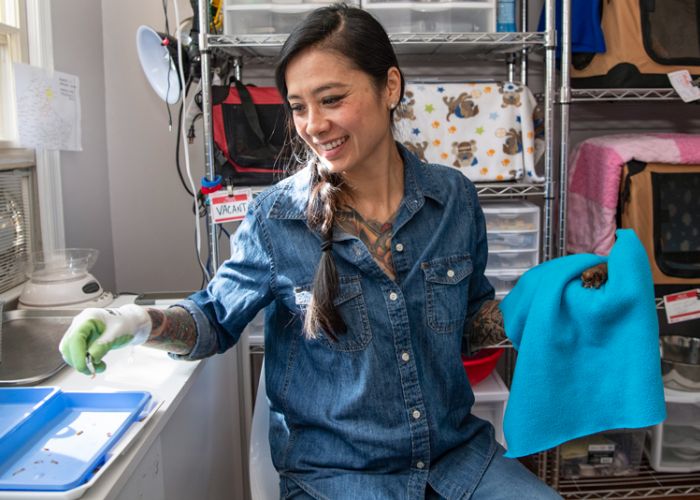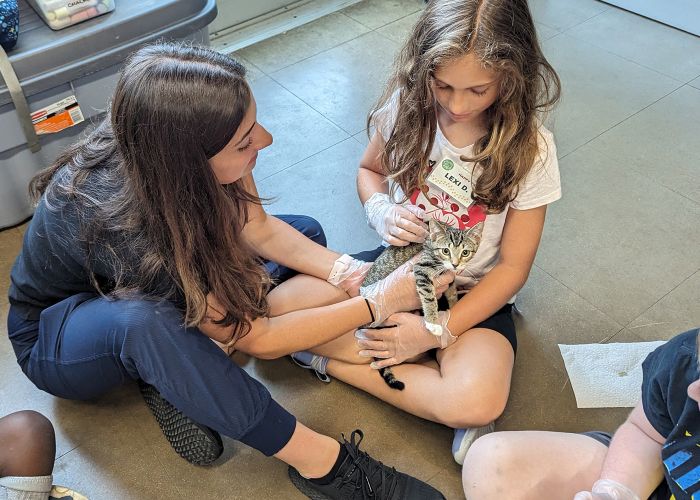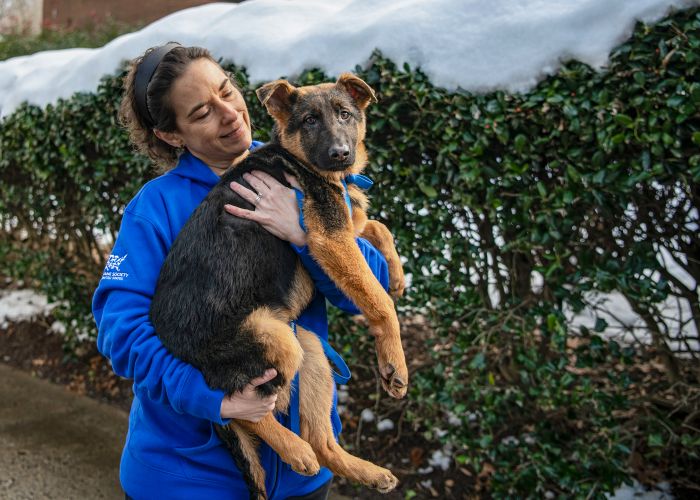Germinating solutions
To prevent infectious diseases from spreading in your shelter, you need to master some sanitation basics

One of my most instructive—and humbling—lessons as a shelter veterinarian came early in my career. At the shelter where I worked, the number of cats with upper respiratory illness was increasing, and the cases were more severe. The staff and I worked diligently to manage the outbreak, but we had more ill cats than isolation space. I kept detailed spreadsheets tracking cases, spent significant funds on diagnostics and therapy, and revised sanitation protocols, but nothing seemed to be helping.
One morning, I was examining a cat during cleaning hours. A staff member came into the room to refill a spray bottle with the bleach-water solution we used for disinfecting cages. She poured a miniscule amount of bleach into the bottle and added water. I asked how she knew the right amount of bleach to use, and she admitted that she usually just dumped some in. I asked some more questions, my heart sinking with every answer. I’d overlooked something so simple. We’d been “disinfecting” with little more than water for months because the written protocol hadn’t been translated into specific actions for the staff who performed daily cleaning. No wonder disease was spreading!
Sound sanitation protocols and practices are truly the root of a healthy animal shelter. Any time an infectious disease issue surfaces, you should perform a firsthand review of your cleaning and disinfecting procedures. Small discrepancies can have a significant impact. Similarly, simple changes can often have widespread, positive and even lifesaving effects. Even during times when infectious disease isn’t a major concern, a regular review of procedures can help keep your shelter in optimal health. Here are some basics of sound sanitation in the shelter environment.
The Right Weapons
First, you have to ensure that your cleaning and disinfecting agents are fully effective against the common pathogens of concern. Some infectious agents persist more readily in a contaminated environment than others. For example, un-enveloped viruses like calici and parvo and parasites like coccidia and fungal ringworm spores are notoriously hard to eradicate.
Shelters today have a wide range of choices of chemicals for cleaning and disinfection, but there are still only a handful that are widely used and have been independently verified as effective against the hardier shelter pathogens. Accelerated hydrogen peroxide, bleach derivatives, quaternary ammonium products and potassium peroxymonosulfate are among the main choices of today’s shelter professionals. Although each has pros and cons that you must consider, shelters that routinely use one of these disinfectants are less likely to have outbreaks or require a change should an outbreak occur.
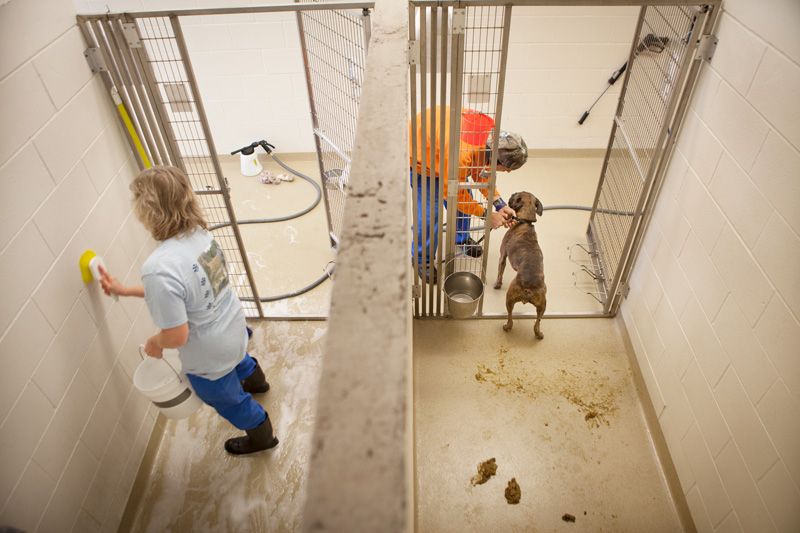
From Policy to Practice
Next, you need to study the actual process of sanitation. Every shelter should have strong written sanitation protocols that are regularly reviewed and, if necessary, updated. If your shelter doesn’t have a written guide, creating one should be a high priority. You want a sound, agreed-upon reference to guide staff now and in the future.
To ensure that the protocols are being followed, shelter staff should periodically observe cleaning procedures from start to finish. As experience taught me, this means paying careful attention to every step—from diluting disinfectant, to changing gloves between each cage, to leaving the disinfectant on the surface for the proper amount of time. This will also help you identify any barriers to effective sanitation (such as a lack of adequate equipment).
Divide and Conquer
Once your shelter has mastered the sanitation basics, take a look at how cleaning tasks are divided among staff. In some shelters, different staff members are responsible for cleaning specific animal areas. This strategy can limit fomite transmission simply by adjusting the number or type of animals that one person is encountering. For example, if the same staff member cleans all of the cat wards, there is a higher risk of transmission of feline disease than if a different person cleans the healthy cat areas and then moves to the dog isolation area. (Of course, if your shelter only has one or two staff members cleaning the entire facility, this strategy may not be practical.)
Step by Step
The order in which animal areas are cleaned is also important, particularly if you have one or two staff members responsible for all the cleaning. A good rule of thumb is to have them start cleaning with the most susceptible animals and end with those who carry the highest risk of transmitting infectious disease. The Association of Shelter Veterinarians recommends that areas with healthy puppies and kittens and nursing mothers be cleaned first, followed by healthy adult animals and ending with unhealthy animals.
What to Wear
Personal protective clothing can substantially reduce fomite transmission (and help protect staff from potential exposure to zoonoses). Ideally, protective clothing should be easy to put on and take off, and either disposable or easily sanitized.
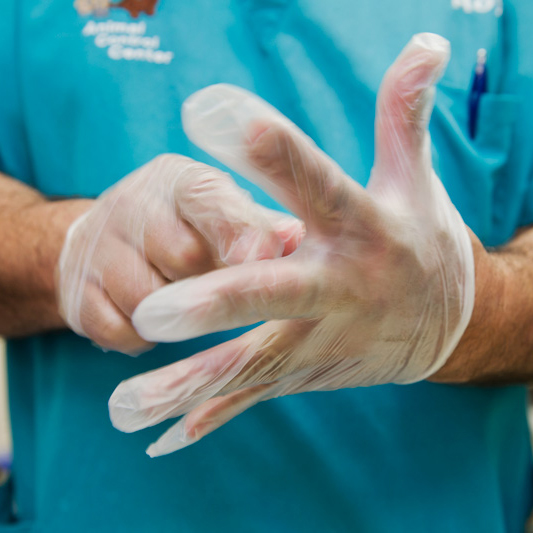
- Disposable gloves provide a simple, inexpensive barrier between the hands and potentially infectious agents. To reduce fomite transmission, they must be changed between handling animals or items in the animals’ environment. Shelters should stock a variety of gloves to accommodate different hand sizes. Some materials tear more easily than others, and it may be worth investing in slightly sturdier gloves. Nitrile and vinyl gloves provide a safe alternative for those with latex allergies.
- Work gloves made from heavy leather, neoprene, nitrile or other materials may protect hands from bites and scratches, but they don’t provide disease barrier protection and can be overlooked in sanitation protocols. It is recommended to wear these over a new pair of clean disposable gloves. Most work gloves can be washed in soap and water, rinsed, sprayed down or soaked in a disinfectant solution, then allowed to thoroughly dry. Including work gloves in a regular sanitation schedule can help limit disease transmission, and you should have multiple pairs so that clean gloves are readily available. Ideally, a clean, disinfected pair of work gloves should be used every time a new animal is handled.
- Gowns, smocks, aprons, scrubs and other types of outerwear come in a variety of styles and materials. Water-resistant materials are important where there is concern for liquid contamination such as during most kennel cleaning processes, or when handling an animal known to have an infectious disease that can be transmitted in bodily fluids. Most protective clothing is sufficient to increase biosecurity, but must be changed regularly to have an effect. This may require that staff change between animal rooms, between particular animals or at other specified intervals determined by shelter protocol.
- Coveralls provide broader protection than other types of outerwear. They’re also available in a variety of different strength materials, but cloth and Tyvek are most common in the shelter. Fabric coveralls are designed to be quickly put on over clothes and can be easily sanitized using normal laundering processes. Tyvek suits are typically used once and then disposed of. Also easy to slip on over clothing, Tyvek is tear-resistant, but not waterproof. If waterproof coveralls are needed, use Tyche or other hazmat textiles.
- Shoe covers, overshoes and boots are the main types of footwear shelter workers use. While it’s important to consider how to minimize fomite transmission by foot traffic, most shoe covers have limitations in the shelter environment. They easily wear through, tend not to be waterproof and can increase the danger of slipping. Overshoes are generally made from materials that can be cleaned and disinfected. Boots that can be cleaned and disinfected, or that remain in designated animal areas, can also help reduce disease transmission.
A Raise of Hands
Although easy to skip, especially in facilities without easy sink access, handwashing has been found to be the most effective method of reducing disease transmission in health care settings. While appropriate use of disposable gloves and occasional use of hand sanitizer (if hands aren’t grossly soiled) is appropriate in the shelter, there is no substitute for repeated and thorough handwashing, using antiseptic soap and water and a protocol such as this:

- Wet hands and forearms with warm water.
- Add 3-5 ml (1-2 full pumps) of soap or disinfecting soap.
- Lather hands and vigorously scrub each side of the hands, under jewelry and fingernails, and up the forearm beyond the wrist. Continue for a minimum of 15 seconds.
- Rinse hands under warm water until no soap remains.
- Dry hands with a paper towel.
Targeted Cleaning
Another way to step up the sanitation in your shelter involves looking at your animal flow and focusing on high-traffic areas. In animal transport vehicles, intake processing rooms, surgery areas and outdoor play yards, the risk of disease transmission is high simply due to the volume and variety of animals passing through these spaces. These areas should contain only easily sanitized surfaces and equipment; be well-stocked with things like gloves, leashes, clean animal-handling equipment and sanitation supplies; and have a written protocol for staff to follow.
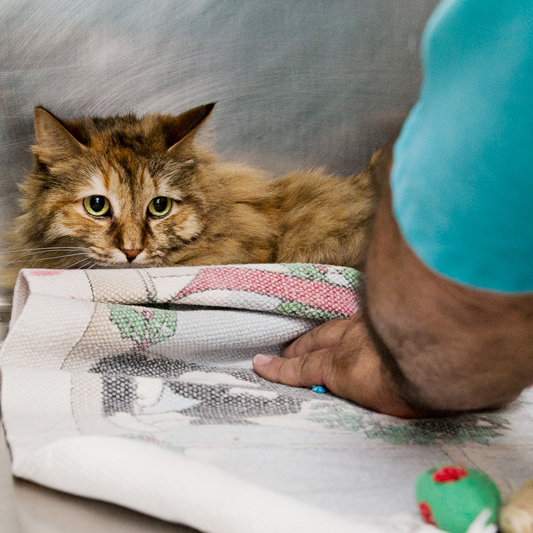
To identify other high-risk areas, walk through the same path animals take as they enter and move through your facility. For example, in a busy surgery room, you may notice how the pulse oximeter probe touches each surgery patient’s tongue and could easily be a source of respiratory disease transmission. It should be disinfected with a safe solution between every animal. The Association of Shelter Veterinarians’ medical care guidelines for spay/neuter clinics recommend that all equipment that has direct patient contact be thoroughly cleaned and disinfected between patients with agents known to destroy common veterinary pathogens. Similarly, endotracheal tubes should be sterile or disinfected with a non-irritating solution prior to use. Anesthetic breathing circuits should be cleaned and disinfected once or twice a week at a minimum. Clippers can allow ringworm to spread if they are not cleaned and disinfected each time they are used.
Finally, you should make sure that all your staff know that sanitation protocols have a direct impact on the animals in your care. More than a few shelters have broken significant, facility-wide disease cycles by strengthening basic sanitation procedures and then digging into the details. Shelters are complex and continually fluctuating in population, pathogens and procedures. But if you’re vigilant and view sanitation as a continually evolving process, you will see the results in healthier, happier animals.


